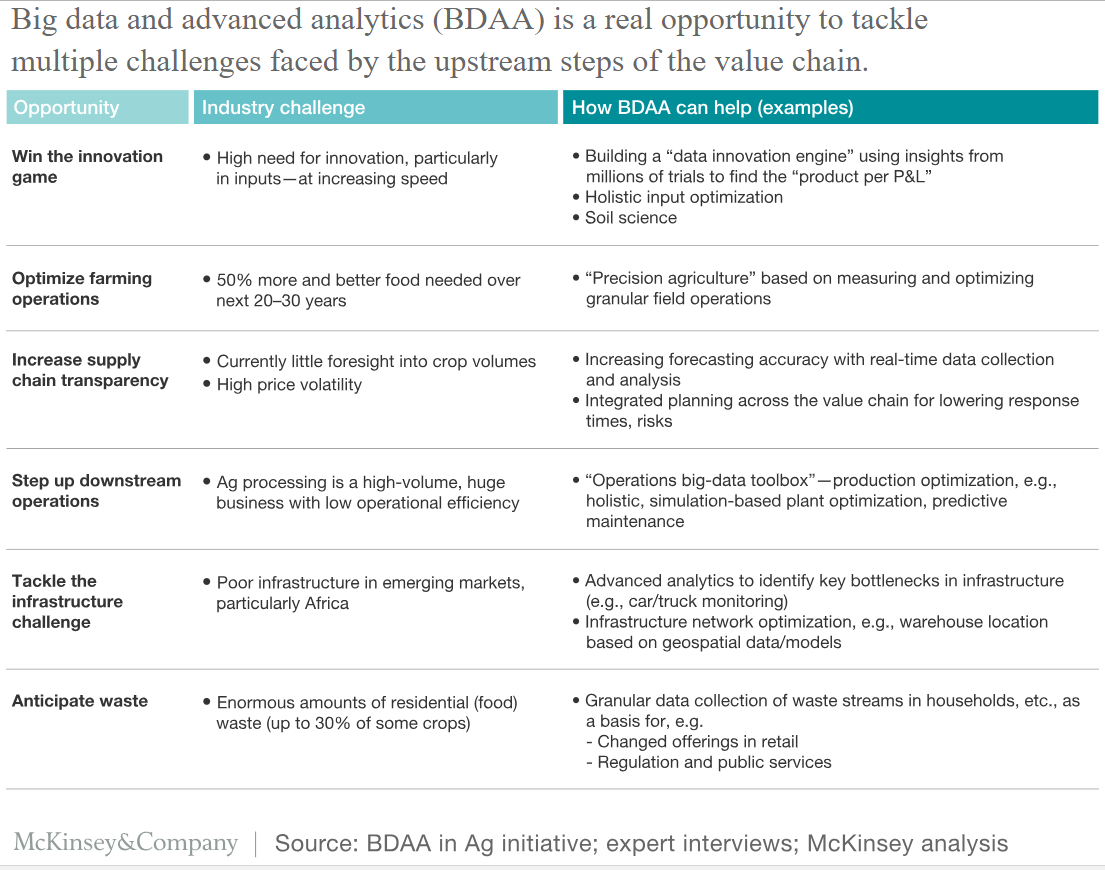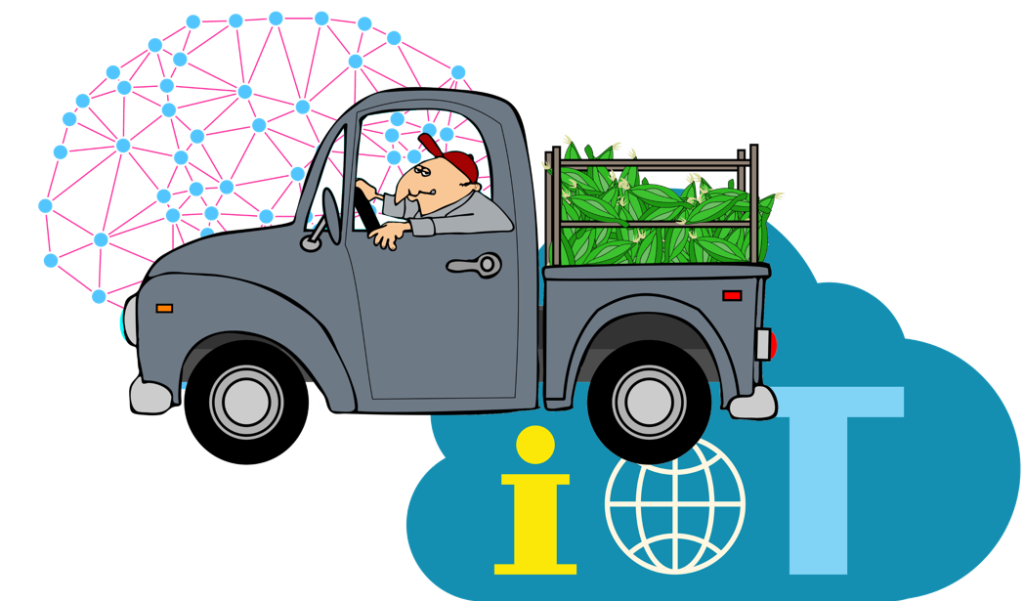Current projections have the global population surpassing 9 billion people by mid-century. Feeding all those people will be a major challenge and we have very few years available to find answers. There are no silver bullet solutions out there. It will take a combination of strategies involving all stakeholders from farmers to consumers to make food security a reality. One of those strategies necessarily involves the food supply chain.
Big Data and the Food Supply Chain
A couple of years ago, Clarisse Magnin wrote, “By taking advantage of big data and advanced analytics at every link in the value chain from field to fork, food companies can harness digital’s enormous potential for sustainable value creation. Digital can help them use resources in a more environmentally responsible manner, improve their sourcing decisions, and implement circular-economy solutions in the food chain.”[1] In her article, she pointed out six areas where big data and advanced analytics provide opportunities to improve the food supply chain. Those areas and opportunities are detailed in the following graphic.

Every one of the opportunities noted above relies on the implementation of an Internet of Things (IoT) ecosystem. The ecosystem consists of sensors (to monitor fields, weather, machinery, etc.) connected by the IoT to advanced analytics platforms (aka cognitive computers). This IoT ecosystem forms the backbone of tomorrow’s automated agricultural sector.
“In the not-too-distant future,” reports Padraig Belton (@PadraigBelton), “our fields could be tilled, sown, tended and harvested entirely by fleets of cooperating autonomous machines by land and air.”[2] Part of the push for fully automated farms comes from the fact people are leaving rural agricultural areas to live in cities. Around 55% of the world’s population currently lives in urban areas, but that percentage is predicted to rise. According to the latest report from the Population Division of the United Nations Department of Economic and Social Affairs, by 2050 over two-thirds (68%) of the world’s population will live in cities. A second, and even more important, reason for automating agriculture is increased food production using fewer resources. Belton explains, “The World Bank says we’ll need to produce 50% more food by 2050 if the global population continues to rise at its current pace. But the effects of climate change could see crop yields falling by more than a quarter. So autonomous tractors, ground-based sensors, flying drones and enclosed hydroponic farms could all help farmers produce more food, more sustainably at lower cost.”
Even before fully automated agriculture can be implemented, a forerunner — called precision agriculture — will benefit from big data and advanced analytics. Linus Blomqvist (@linusblomqvist), Director of Conservation at Breakthrough, and David Douglas (@nearwalden), Vice President of Applied Invention, explain, “In the past few decades, innovators, agronomists, and farmers have developed a powerful suite of technologies and practices under the banner of precision agriculture, which has played a large and underappreciated role in driving up yields and reducing pollution. Looking forward, precision agriculture presents some of the best opportunities to meeting growing global food demand while minimizing environmental impacts. As such, it needs to become a central component of the conversation about agricultural innovation and sustainability.”[3]
Logistics Role in the Food Supply Chain
In addition to potential breakthroughs on the farm, there is a lot that can be done between farm to fork. Subhash Chowdary, founder and CEO of Aankhen Inc., observes, “Agriculture is a global business. Bananas can come from Philippines, Africa, South/Latin America. Coffee, sugar, cocoa, fruits, vegetables and roses for Valentine’s Day come from all over the world. Global sourcing makes year-round availability of fresh produce possible with supply chain and cold chain logistics.”[4]
As Magnin noted, food waste is a big problem and, as such, a big opportunity. She explains, “Big data and advanced analytics can be used to optimize downstream activities such as waste management. Food waste causes economic losses, harms natural resources, and exacerbates food-security issues. About a third of food produced for human consumption is lost or wasted every year in a world where 795 million people — a ninth of the population — go hungry. Cutting post-harvest losses in half would produce enough food to feed a billion more people.” Waste occurs throughout the supply chain — on the farm, in transit, at the retailer, and with the consumer. Logistics obviously is the major player during the “in transit” phase of the food supply chain.
Brittany Martincic notes, “The ability to maintain temperature stability is extremely important when dealing with perishable foods. Fresh vegetables could last a week if the temperature does not fluctuate, but perishable foods will not last if temperature increases for a period of hours. According to the Food and Agriculture Organization of the United Nations, up to one-third of food perishes in transit every year. IoT based on connected sensing technology can minimize the loss of vegetables due to temperature fluctuations. It provides the exchange of critical real-time information and supply chain visibility, reducing the possibility of a disruption.”[5] There is another health issue that can also be addressed using Digital Age technologies — food recalls. Technologies like blockchain can help trace tainted food to precise processes or fields so that recalls don’t involve discarding untainted food as a result of not knowing where it was processed or grown.
Summary
Chowdary concludes, “Every process, system and resource used in the agri ecosystem can be improved significantly. The resources used in the agri ecosystem include farmlands, equipment (tractors, trucks, harvesters, containers, chassis, reefers, gensets), materials (fertilizers, pesticides, seeds), warehouses, cold storage, processing facilities (machinery), packaging (boxes, containers) and people (farmers, farm labor, equipment operators, mechanics, truck drivers, managers, mill owners, bankers, insurance). Using IoT in logistics increases the efficiency and utilization of physical and financial resources in the production and distribution of product.” Belton reports, “From 1950 to 2010, according to the International Labor Organization (ILO), agricultural laborers as a percentage of the workforce declined from 81% to 48.2% in developing countries, and from 35% to 4.2% in developed ones.” In the United States, there is a growing shortage of truck drivers. Automation and artificial intelligence can help close growing employment gaps as well as help make farm to fork processes more efficient and effective.
Footnotes
[1] Clarisse Magnin, “How big data will revolutionize the global food chain,” McKinsey & Company, August 2016.
[2] Padraig Belton, “In the future, will farming be fully automated?” BBC News, 25 November 2016.
[3] Linus Blomqvist and David Douglas, “Is Precision Agriculture the Way to Peak Cropland?” The Breakthrough, 7 December 2016.
[4] Subhash Chowdary, “IoT in logistics: Where’s the money? Part 2,” IoT Agenda, 28 February 2017.
[5] Brittany Martincic, “How IoT is Driving Supply Chain Innovation,” datex, 2018.





